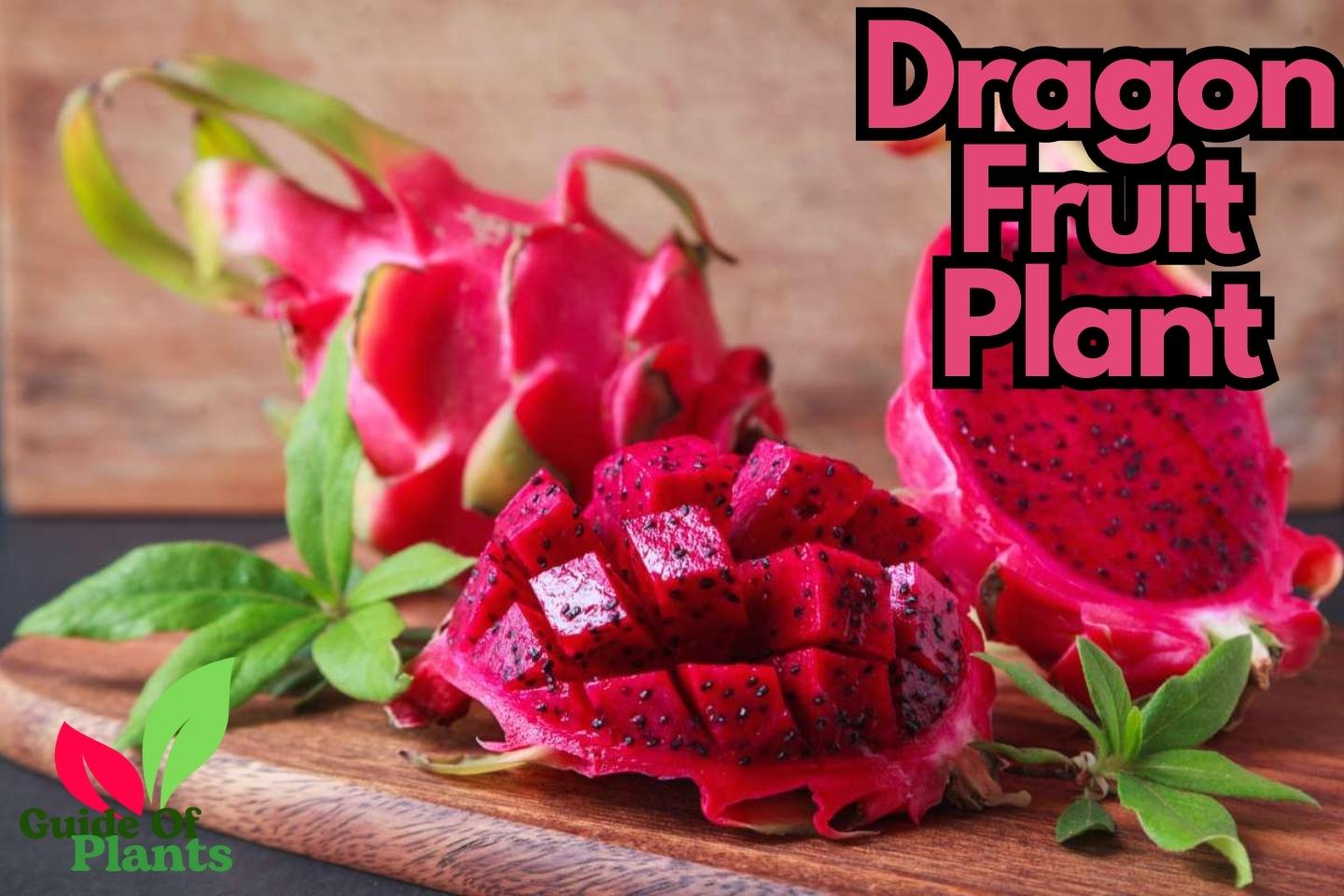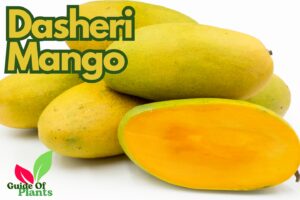Dragon fruit, also known as pitaya or the strawberry pear is an exotic and nutritious fruit grown on vining cacti. The oval-shaped fruit has a vibrant pink or yellow peel with small branching spikes. The creamy white or magenta flesh inside is dotted with tiny edible black seeds. Growing dragon fruit plant at home can be highly rewarding.
These hardy plants produce juicy, sweet fruits packed with vitamin C, calcium, antioxidants, and fiber. Additionally, the unique plant has ornamental value with large, fragrant flowers. Read on to learn everything about successfully growing dragon fruit in your own backyard. Let’s start with Guide of Plants.
Table of Contents
Know About:
What is Dragon Fruit?
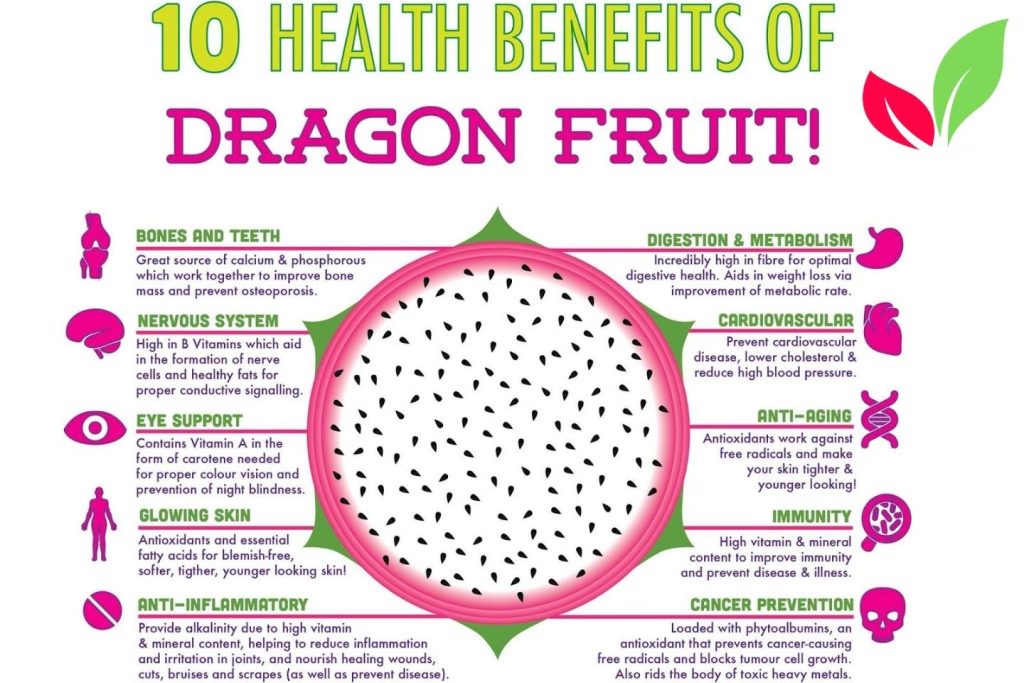
Dragon fruit is the fruit of several cactus species in the Hylocereus genus, native to tropical regions of Mexico and Central and South America. Some common varieties include the red-skinned H. coccineus, the yellow-skinned H. megalanthus, and the popular high-yielding H. undatus with magenta flesh.
The pitaya or pitahaya fruit has gained immense popularity for its nutrition profile. It contains fiber, vitamin C, lycopene, betalains, polyunsaturated fatty acids, phenolic acids, and carotenoids. These compounds make dragon fruit an antioxidant superfood.
Benefits of Growing Dragon Fruit at Home
Cultivating your own dragon fruit at home has many advantages:
- Get access to organic, fresh-off-the-vine dragon fruit whenever you want.
- Dragon fruit plants have ornamental value with large, fragrant, night-blooming flowers.
- You can customize the flavor profile by trying different species and cultivars.
- Requires minimal care and maintenance once established.
- Dragon fruit can be grown in spaces like balconies and patios using containers.
- Provides an exotic tropical appeal to any garden or landscape.
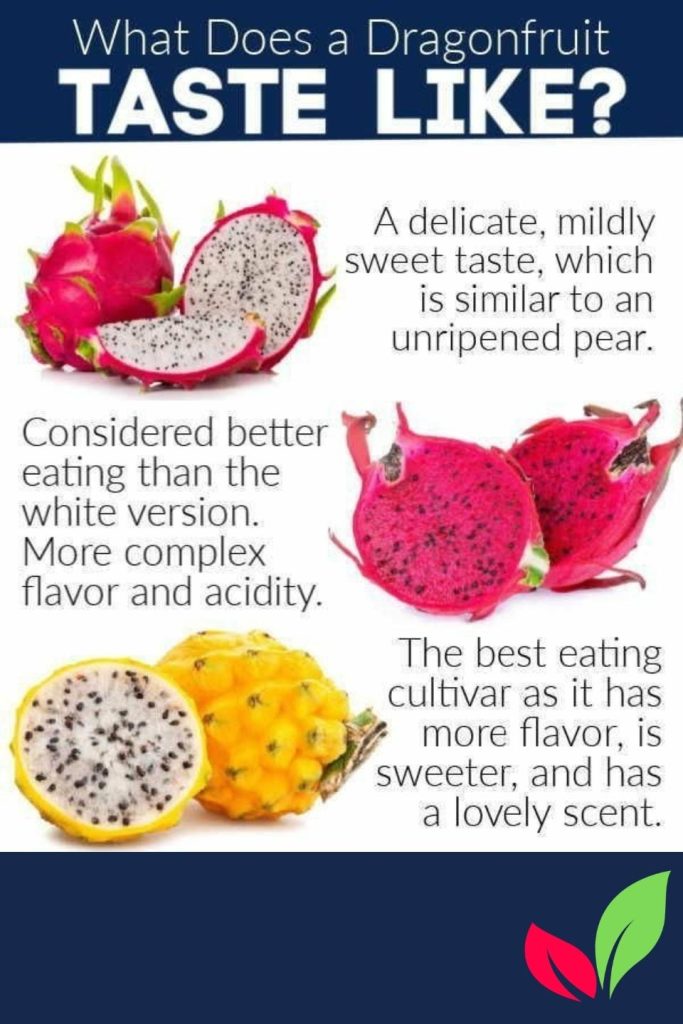
Getting Started with Dragon Fruit Cultivation
Growing dragon fruit is easy once you understand the basic needs of the plant. Here is what you need to get started:
Choosing the Right Variety of Dragon Fruit
Select cold-hardy, high-yielding varieties suited for your climate. H. undatus and H. coccineus are excellent choices for home gardens. Consult local nurseries for the best regional varieties.
Understanding Dragon Fruit Plant Anatomy
The plant has a succulent stem that grows into long, sprawling vines. The stems have aerial roots that cling to supports. Large, fragrant flowers bloom at night. Pollinated flowers develop into pink or yellow dragon fruits.
Best Time for Planting Dragon Fruit
Spring and early summer are ideal planting times to give new plants time to establish before winter. Plant 1-2 months after the last frost date for your area.
Setting Up the Ideal Growing Environment
Dragon fruit cacti thrive in warm, dry, tropical climates. Replicate these conditions for successful cultivation at home:
Selecting the Right Location for Planting
Pick a warm, sunny location protected from strong winds. Dragon fruit needs 6-8 hours of full sun daily. Provide shade in very hot summers.
Preparing the Soil for Dragon Fruit Planting
Improve drainage in heavy clay soils by mixing in compost. Dragon fruit thrives in sandy, well-draining soil with a pH of 5.5-7.
Using Containers vs. Planting in the Ground
Grow in at least 25-gallon containers with drainage holes if space is limited. Amend potting mix with perlite or gravel to improve drainage.
Planting Dragon Fruit

Dragon fruit is commonly propagated from cuttings for commercial cultivation. You can also start plants from seed:
Propagation Methods: Seeds vs. Cuttings
Seeds – Slower to fruit (3-4 years) but add genetic diversity. Sow seeds 1⁄4-inch deep in spring.
Cuttings – Quicker fruiting (1-2 years) but are clones. Take 12-20 inch tip cuttings in spring and root in potting mix.
Steps for Planting Dragon Fruit Cuttings
- Trim cuttings below a stem joint and allow to callus for 4-7 days.
- Plant callused end 2 inches deep in potting mix, leaving 2 buds above the surface.
- Water sparingly until new growth emerges in 6-8 weeks. Then water deeply.
Caring for Dragon Fruit Seedlings
Transplant seedlings when they develop 3-4 sets of leaves. Bury the lower stem and water well after transplanting.
Essential Care Tips for Dragon Fruit Plants
The following are the proper care techniques for the health and productivity of dragon fruit plants:

- Watering Techniques and Frequency
- Water young plants every 2-3 days.
- Established plants need weekly watering.
- Soak the entire root zone thoroughly and allow the soil to dry out partially between waterings.
- Fertilizing Dragon Fruit Plants
- Use balanced fertilizer monthly in the growing season.
- Mind the dosage to avoid burn.
- Top dress with compost or manure every spring.
- Avoid high-nitrogen fertilizers.
- Mulching for Soil Moisture Retention and Weed Control
- Apply 2-4 inches of organic mulch around plants.
- Replenish as needed.
- Pruning to Promote Growth and Shape the Plant
- Prune annually in late winter to remove dead stems and shape plants.
- Pinch off stem tips during summer to encourage branching and manage size.
- Protecting Dragon Fruit from Pests and Diseases
- Dragon fruit plants are generally vigorous but can be affected by some pests and diseases.
- Common pests affecting dragon fruit plants include mealybugs, aphids, and scale insects. These can be controlled with neem oil or insecticidal soap sprays.
- Snails and slugs can also be a problem. These can be removed by hand or using iron phosphate baits.
- Natural and organic pest control methods include spraying neem oil, pyrethrin, or Azera, introducing ladybugs and lacewings, using sticky barriers against crawling pests, and setting out beer traps for slugs.
- Common dragon fruit diseases include Fusarium stem rot and powdery mildew. Fusarium stem rot causes wilting. It can be prevented by improving drainage and avoiding overwatering. Powdery mildew leads to white fungus coating on leaves. It can be prevented by applying neem oil regularly.
Know About: Miyazaki Mango Plant
Training and Supporting Dragon Fruit Growth
Dragon fruit plants produce long vining stems that require proper support:
- Providing Adequate Support for Vining Dragon Fruit Varieties: Install sturdy trellises, pergolas, or wires for the vines to climb. Position these structures before planting.
- Training Dragon Fruit to Climb Trellises or Fences: Gently tie young shoots to supports. Continue training vines as they elongate.
- Trimming and Supporting Epiphytic Dragon Fruit Species: Some species, like H. undatus, form aerial roots and can be trained up trees and structures. Trim to contain growth.
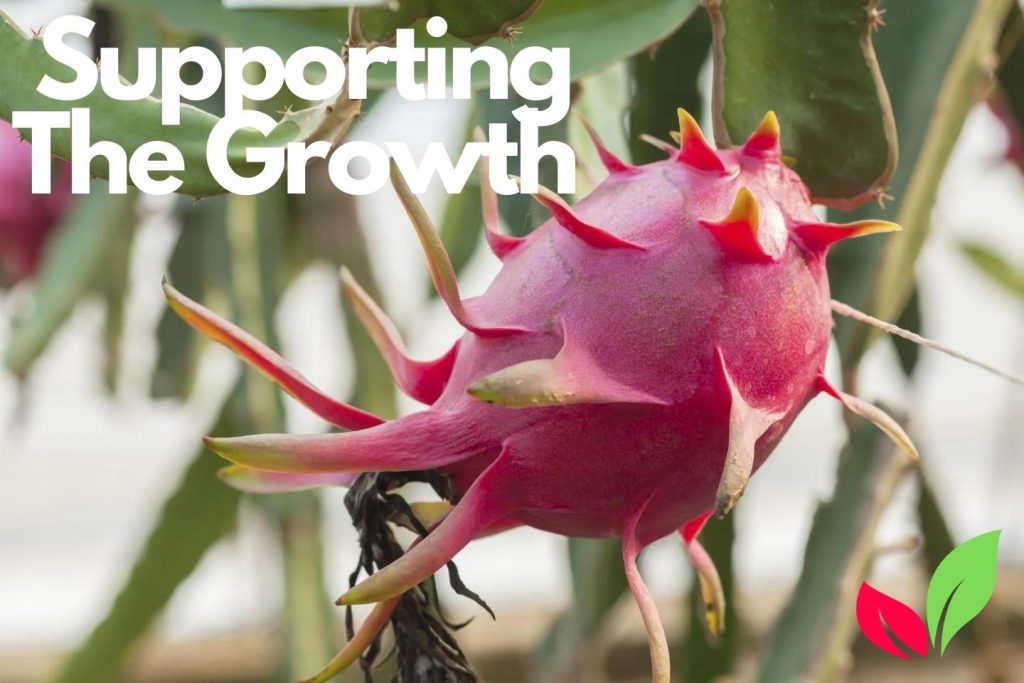
Optimizing Dragon Fruit Flowering and Pollination
Getting ample fruit set depends on robust flowering and effective pollination:
Understanding the Dragon Fruit Flowering Process: Flowering occurs in late spring/early summer and continues for 4-6 weeks. Large, fragrant white flowers open at night and close by late morning. Each flower blooms for one night only. But many flowers bloom sequentially.
Promoting Pollination for Fruit Set: Cross-pollination is required for pollination. Attract nocturnal pollinators like bats and moths.
Hand Pollination Techniques: Use a small brush to transfer pollen from fresh male to female flowers. Mark pollinated flowers.
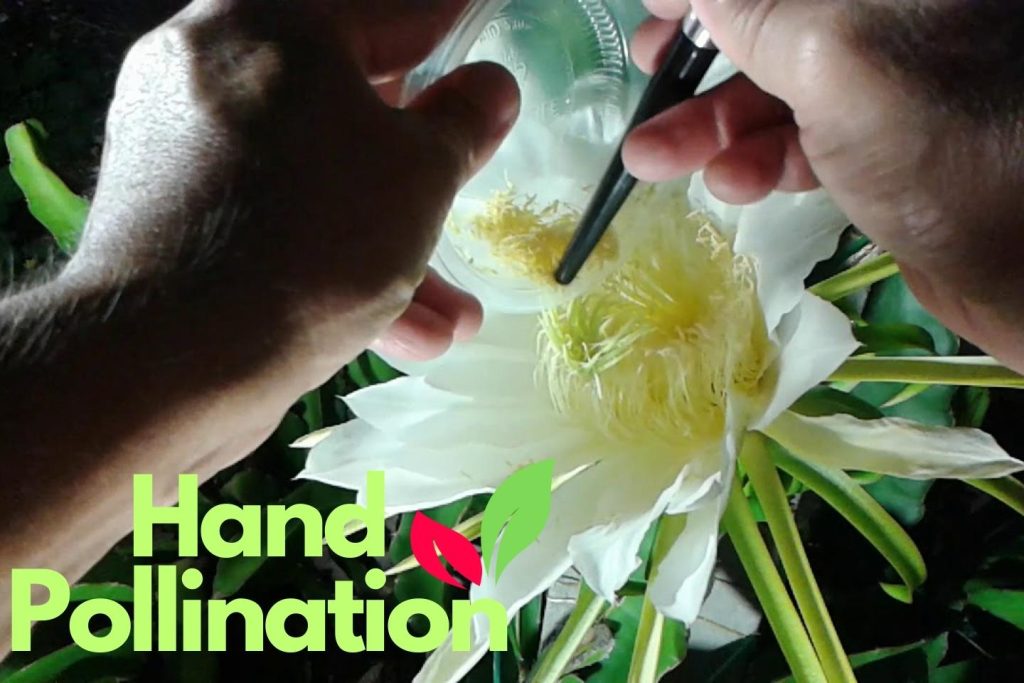
Dealing with Common Growing Challenges
Be aware of these potential issues and how to address them:
Addressing Overwatering and Underwatering Issues
Overwatering encourages rot, while underwatering stunts growth. Stick to a consistent schedule based on your environment.
Managing Sunlight and Shade Requirements
Insufficient sun exposure inhibits flowering and fruiting. Supplement with grow lights if needed.
Handling Temperature Extremes and Frost
Dragon fruit can tolerate light frost but sustained cold damages plants. Use covers and heat lamps to protect plants.
Practical Tips for Successful Dragon Fruit Cultivation
Follow these useful tips for getting the most out of your dragon fruit plants:
Intercropping and Companion Planting with Dragon Fruit
Grow shade-tolerant herbs, lettuce, and spinach below the vines.
Using Artificial Lighting for Indoor Cultivation
Supplement sunlight with full-spectrum LED grow lights. Provide 14-16 hours of daily light exposure.
Propagating Dragon Fruit for Expansion
Take tip cuttings in spring from healthy mother plants. Root cuttings and plant in containers or open ground.
Harvesting and Storing Dragon Fruit
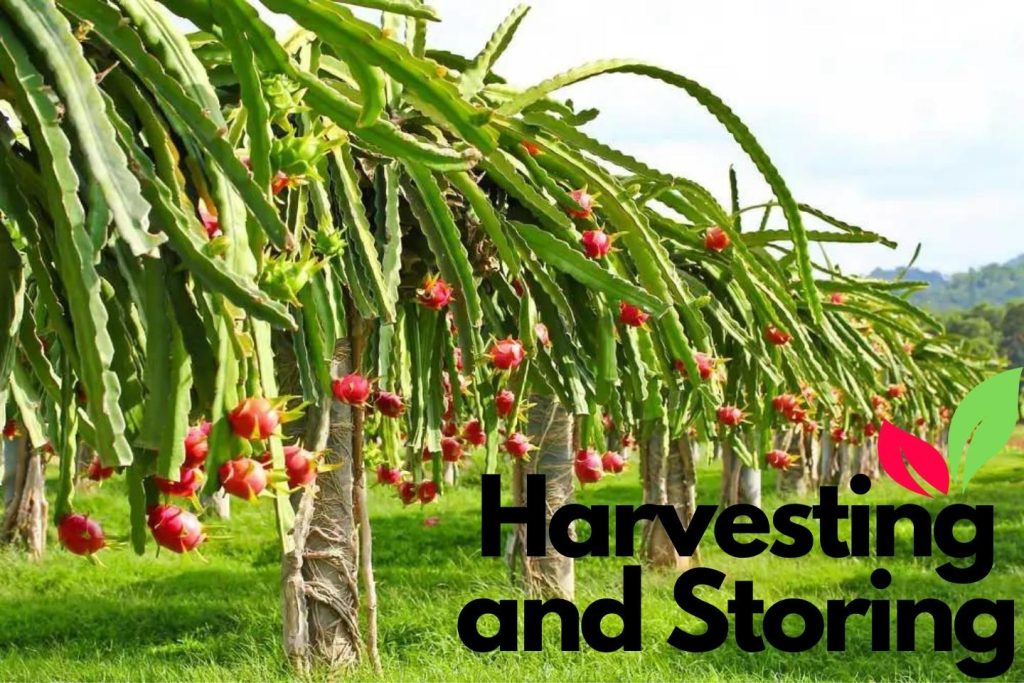
With proper care, you can enjoy fresh dragon fruit from mid-summer through fall:
Determining the Right Time for Harvesting
Dragon fruit should be harvested when the bracts protecting the fruit start wilting and browning.
Properly Harvesting Ripe Dragon Fruits
Use pruning shears to snip the fruit from the stem carefully. Pick fruit carefully to avoid bruising.
Storing and Preserving Dragon Fruit
Store freshly picked dragon fruit at room temperature for 5-7 days. Refrigerate ripe fruit for 2-3 weeks. Freeze pulp for longer storage. Make jams, juices, smoothies, and wine with excess harvest.
Know About: Alphonso Mango Plant (Mangifera Indica Mango)
Conclusion
Few fruits match the unique look and taste of scarlet dragon fruit straight from the vine. Plus, the climbing cacti add a beautiful structure to any landscape. Implement the tips in this guide and enjoy growing this tropical plant at home. Dragon fruit is sure to be a conversation starter for any garden. Though it hails from the tropics, climate-appropriate varieties can thrive with minimal care. Provide the right growing conditions and essential plant care, and you will be harvesting delicious, nutritious dragon fruit for years to come.

